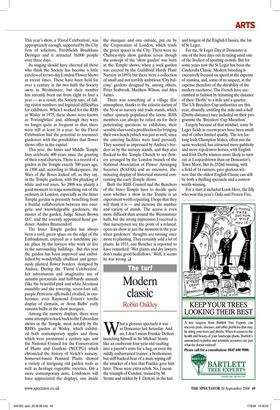Modern classic
Robin Oakley
What a glorious spectacle it was at Doncaster last Saturday. And no, I don’t mean Frankie Dettori launching himself at Sir Michael Stoute like an exuberant four-year-old vaulting into a parent’s arms for a hug, or even the mildly embarrassed trainer, a bonhomous but stiff-backed bear of a man, wiping off the smacker of a kiss that Frankie gave him later. Those were extra relish. No, I mean the triumph of Conduit, trained by M. Stoute and ridden by F. Dettori, in the last and longest of the English Classics, the 1m 6f St Leger.
For me, St Leger Day at Doncaster is one of the best days out in racing amid one of the liveliest of sporting crowds. But for some years now the St Leger has been the Cinderella Classic. Modern breeding is excessively focused on speed at the expense of stamina, and, some of us suspect, at the expense therefore of the durability of the modern racehorse. The French have succumbed to fashion by trimming the distance of their ‘Derby’ to a mile and a quarter. The US Breeders Cup authorities are this year, absurdly, entitling the mile-and-a-half (Derby-distance) race included on their programme the ‘Breeders’ Cup Marathon’.
Largely because of that mindset, some St Leger fields in recent years have been small and of rather limited quality. The ten furlong Irish Champion Stakes, often run the same weekend, has attracted more publicity and more top-drawer horses, with English and Irish Derby winners more likely to turn out at Leopardstown than on Doncaster’s Town Moor. But its 232nd running, with a field of 14 runners, gave glorious witness that the oldest English Classic can still be both a thrilling spectacle and a contest worth winning.
For a start it included Look Here, the filly who won this year’s Oaks and Frozen Fire, who won the Irish Derby for Aidan O’Brien.
There cannot be much wrong with a race for which the all-conquering O’Brien sends over a team of five from Ireland and in which Sir Michael Stoute, England’s champion, fields three. Victory for one of those three, despite the added handicap of carrying a few bob from your correspondent, was especially sweet for all Doncaster regulars. Since his first St Leger entrant in 1974 Sir Michael had provided another 24 runners, but although they included the great Shergar (on going which did not suit) it remained the one race he seemingly could not win. Along with his five 2000 Guineas, four Epsom Derbies, and a brace each of 1000 Guineas and Oaks winners, he had only a maddening five second places to show for his efforts in the St Leger.
Think Henman and Wimbledon, Frankie Dettori and the Derby and imagine how heartily sick Stoute must have become of those ‘When is he going to do it?’ headlines before the race and ‘Stoute’s hoodoo strikes again’ post-mortems.
Ironically, when he did it, it was not in association with his talented young stable jockey, the champion-in-waiting Ryan Moore. Despite an impressive final gallop from Conduit, Moore had decided that the ground would not suit Conduit and chose to ride Doctor Fremantle instead. So since Sheikh Mohammed’s Godolphin had no St Leger runner, the ride was offered to Dettori. And what a glorious demonstration he gave of his enduring value as a big race jockey in a race he had already won four times, for Godolphin, O’Brien, John Gosden and Jeremy Noseda.
Dettori’s post-race antics as he works the victory ‘high’ out of his system, the hands raised to Heaven or whoever he sees up there, the flying dismounts, the crowd-conducting, the kisses sprayed around connections, are of inestimable value to a sport short on characters with his ebullience and popular appeal. But what tends to be forgotten is his sheer tactical brilliance and instinctive horsemanship. Amid all that crowd-pleasing there are often valuable words to be heard in Frankie’s post-race analysis.
‘They went off very fast,’ he said, ‘and I knew I was on a stayer.’ While Hindu Kush and Warringah and the 200-1 outsider Maidstone Mixture pulled the field along at a stiff pace, Frankie was content to wait near the back of the pack in the blue silks of the Ballymacoll Stud. Two furlongs out, feeling plenty of horse under him, he knew it was time to press the button. He cruised to the front and dared the others to come and peg him back. Only the two fillies in the race, Look Here and Ireland’s Unsung Heroine, proved capable of setting out after him but, despite one jink to the right, Conduit ran on readily to win by a comfortable three lengths. And the good news is that both Conduit and Look Here will be racing on next year.
Conduit’s victory was a fine achievement for all concerned, not least the colt himself whose dam died giving birth to him and whose first racecourse victory had been in a low-class evening race at Wolverhampton. It was not so good, of course, for poor Ryan Moore, who is yet to ride a Classic winner and who could finish only eighth on Doctor Fremantle. There Frankie was full of sympathy. ‘I’ve been there myself,’ he declared. Stable jockeys don’t always get those choices right.
Surprisingly, the best place obtained by any of the O’Brien horses was by pacemaker Hindu Kush in fourth, at 200-1. So is O’Brien slipping? Not quite. When his Septimus won the Irish St Leger the same afternoon at the Curragh it was not only Aidan’s 19th Group One of the season. It meant that he had won all five of the Irish Classics this year. ❑











































































 Previous page
Previous page